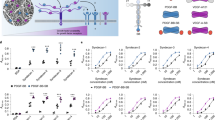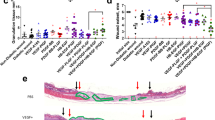Abstract
In the absence of heparan sulfate (HS) on the surface of target cells, or free heparin (HP) in the vicinity of their receptors, fibroblast growth factor (FGF) family members cannot exert their biological activity and are easily damaged by proteolysis. This limits the utility of FGFs in a variety of applications including treatment of surgical, burn, and periodontal tissue wounds, gastric ulcers, segmental bony defects, ligament and spinal cord injury. Here we describe an FGF analog engineered to overcome this limitation by fusing FGF-1 with HS proteoglycan (PG) core protein. The fusion protein (PG–FGF-1), which was expressed in Chinese hamster ovary cells and collected from the conditioned medium, possessed both HS and chondroitin sulfate sugar chains. After fractionation, intact PG–FGF-1 proteins with little affinity to immobilized HP and high-level HS modification, but not their heparitinase or heparinase digests, exerted mitogenic activity independent of exogenous HP toward HS-free Ba/F3 transfectants expressing FGF receptor. Although PG–FGF-1 was resistant to tryptic digestion, its physiological degradation with a combination of heparitinase and trypsin augmented its mitogenic activity toward human endothelial cells. The same treatment abolished the activity of simple FGF-1 protein. By constructing a biologically active proteoglycan–FGF-1 fusion protein, we have demonstrated an approach that may prove effective for engineering not only FGF family members, but other HP-binding molecules as well.
This is a preview of subscription content, access via your institution
Access options
Subscribe to this journal
Receive 12 print issues and online access
$209.00 per year
only $17.42 per issue
Buy this article
- Purchase on Springer Link
- Instant access to full article PDF
Prices may be subject to local taxes which are calculated during checkout





Similar content being viewed by others
References
McKeehan, W.L., Wang, F. & Kan, M. The heparan sulfate–fibroblast growth factor family: diversity of structure and function. Prog. Nucleic Acid Res. Mol. Biol. 59, 135–176 (1998).
Thornton, S.C., Mueller, S.N. & Levine, E.M. Human endothelial cells: use of heparin in cloning and long-term serial cultivation. Science 222, 623–625 (1983).
Imamura, T. & Mitsui, Y. Heparan sulfate and heparin as a potentiator or a suppressor of growth of normal and transformed vascular endothelial cells. Exp. Cell Res. 172, 92–100 (1987).
DiGabriele, A.D. et al. Structure of a heparin-linked biologically active dimer of fibroblast growth factor. Nature 393, 812–817 (1998).
Schreiber, A.B. et al. Interaction of endothelial cell growth factor with heparin: characterization by receptor and antibody recognition. Proc. Natl. Acad. Sci. USA 82, 6138–6142 (1985).
Pineda-Lucena, A. et al. Three-dimensional structure of acidic fibroblast growth factor in solution: effects of binding to a heparin functional analog. J. Mol. Biol. 264, 162–178 (1996).
Rosengart, T.K., Johnson, W.V., Friesel, R., Clark, R. & Maciag, T. Heparin protects heparin-binding growth factor-I from proteolytic inactivation in vitro. Biochem. Biophys. Res. Commun. 152, 432–440 (1988).
Kojima, T., Inazawa, J., Takamatsu, J., Rosenberg, R.D. & Saito, H. Human ryudocan core protein: molecular cloning and characterization of the cDNA, and chromosomal localization of the gene. Biochem. Biophys. Res. Commun. 190, 814–822 (1993).
Esko, J.D., Stewart, T.E. & Taylor, W.H. Animal cell mutants defective in glycosaminoglycan biosynthesis. Proc. Natl. Acad. Sci. USA 82, 3197–3201 (1985).
Imamura, T., Oka, S., Tanahashi, T. & Okita, Y. Cell cycle-dependent nuclear localization of exogenously-added fibroblast growth factor-1 in BALB/c3T3 and human vascular endothelial cells. Exp. Cell Res. 215, 363–372 (1994).
Shworak, N.W., Shirakawa, M., Mulligan, R.C. & Rosenberg, R.D. Characterization of ryudocan glycosaminoglycan acceptor sites. J. Biol. Chem. 269, 21204–21214 (1994).
Ornitz, D.M. et al. Heparin is required for cell-free binding of basic fibroblast growth factor to a soluble receptor and for mitogenesis in whole cells. Mol. Cell. Biol. 12, 240–247 (1992).
Imamura, T. et al. Recovery of mitogenic activity of a growth factor mutant with a nuclear translocation sequence. Science 249, 1567–1570 (1990).
Kato, M. et al. Physiological degradation converts the soluble syndecan-1 ectodomain from an inhibitor to a potent activator of FGF-2. Nat. Med. 6, 691–697 (1998).
Yoneda, A., Asada, M., Suzuki, M. & Imamura, T. Introduction of an N-glycosylation cassette into proteins at random sites: expression of neoglycosylated FGF. BioTechniques 27, 576–582 (1999).
Asada, M. et al. The AATPAP sequence is a very efficient signal for O-glycosylation in CHO cells. Glycoconj. J. 16, 321–326 (1999).
Acknowledgements
We thank Drs. Chie Matsuda and Syuichi Oka, and Ms. Kazuko Miyakawa at NIBH for technical assistances and discussions. The text was edited by Dr. William Goldman at MST Editing Company. This study was supported by a AIST project of Complexed Carbohydrate to T.I., M.A., and M.S. and by a STA-COE grant and a AIST-HFSP grant to T.I. A.Y. was supported by a NEDO postdoctoral fellowship.
Author information
Authors and Affiliations
Corresponding author
Rights and permissions
About this article
Cite this article
Yoneda, A., Asada, M., Oda, Y. et al. Engineering of an FGF–proteoglycan fusion protein with heparin-independent, mitogenic activity. Nat Biotechnol 18, 641–644 (2000). https://doi.org/10.1038/76487
Received:
Accepted:
Issue Date:
DOI: https://doi.org/10.1038/76487
This article is cited by
-
Impaired wound healing in bleomycin-induced murine scleroderma: a new model of wound retardation
Archives of Dermatological Research (2016)
-
Vascular leakage in chick embryos after expression of a secreted binding protein for fibroblast growth factors
Laboratory Investigation (2005)



